Surf Lessons in Australia: A Comprehensive Guide
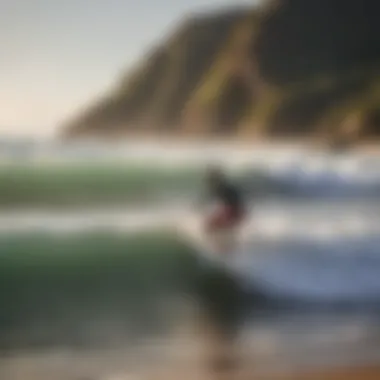
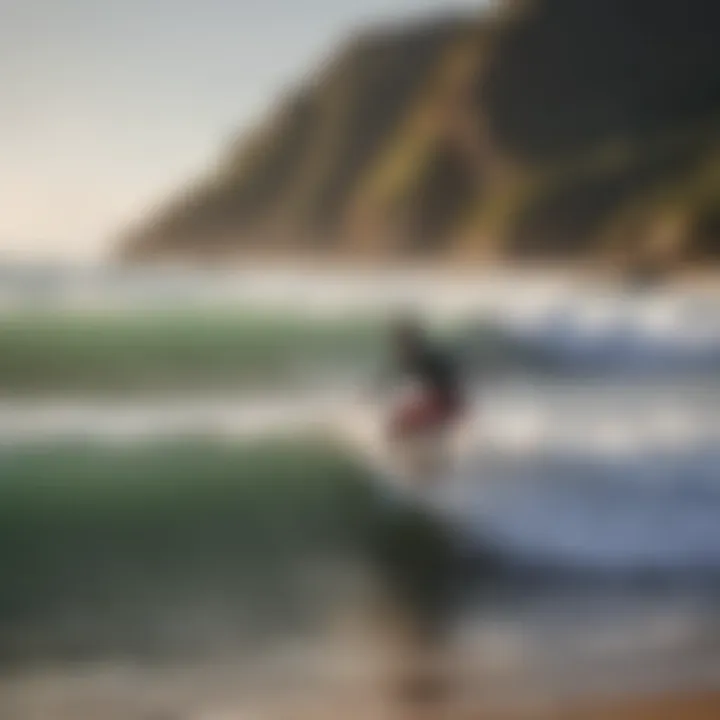
Intro
Australia is often seen as the ultimate playground for surf enthusiasts. With its picturesque coastline stretching more than 36,000 kilometers, each wave seems to beckon to both the novice and the seasoned surfer alike. From the rolling swells of Byron Bay to the challenging breaks at Margaret River, the nation offers a plethora of surf schools and lessons tailored to suit all skill levels.
A dive into surf lessons here means not only learning to ride the waves but also understanding the unique cultures that accompany each surf location. Not to mention the various methodologies that schools adopt, choosing the right one can significantly impact the learning journey.
Safety is another crucial aspect that cannot be overlooked. Knowing the ins and outs of currents and weather conditions helps prevent mishaps, especially for those just starting out. In this guide, we will explore key techniques, the essential gear participants should consider, and provide insight into how to make the most of your surfing lessons in Australia.
Techniques and Skills
Essential Techniques for Beginners
For those stepping onto a surfboard for the first time, mastering the core fundamentals is critical. Some of the foundational skills include:
- Paddling: This is the bread and butter of surfing. Understanding how to paddle effectively will get you out into the lineup and onto the waves.
- Pop-up: The action of going from lying on the board to standing in one motion is known as the pop-up. Learning this well, while keeping your weight centered, is vital for maintaining balance.
- Wave Selection: Not all waves are created equal. Beginners often struggle with this part, but learning to identify the right wave can make the difference between a thrilling ride and a wipeout.
Practice makes progress, but having a skilled instructor can fast-track your abilities immensely. This hands-on approach ensures you’re picking up the nuances rather than merely going through the motions.
Advanced Skills for Experienced Watersport Enthusiasts
For those who have already conquered the basics and are ready to take their surfing to new heights, it’s time to refine and expand upon existing strengths. Advanced skills might include:
- Carving: This involves making tight turns on the wave, which requires skillful weight distribution and foot placement.
- Aerial Maneuvers: This daring skill takes confidence, as it involves launching off the wave and performing tricks while in the air.
- Tuning into Conditions: Experienced surfers know that every surf session is dictated by environmental factors such as tide, wind, and swell direction. Developing a keen sense for these can significantly enhance performance and safety.
Surf schools specializing in advanced lessons often focus on personalized feedback, so surfers can hone in on specific areas for improvement.
Equipment and Gear
Must-Have Gear for Each Watersport
Surfing doesn't just require skill – it also demands the right gear. Different types of equipment play a crucial role in ensuring safety and enhancing performance. Essential gear includes:
- Surfboards: Choosing the right surfboard tailored to your skill level is fundamental. Soft-tops are ideal for beginners, while more experienced surfers may opt for shortboards or longboards based on their preferences.
- Wetsuits: Depending on the water temperature and season, a wetsuit can provide insulation and protection against the elements.
- Leash: Often overlooked, the leash keeps the surfboard tethered to the surfer, preventing runaway boards from becoming a hazard.
Tips for Selecting the Right Equipment
When it comes to surf equipment, the choices can feel overwhelming. Finding the correct gear doesn’t have to be daunting. Here are some tips:
- Do your research: Familiarize yourself with the types of surfboards and gear available. Surf shop staff can be a wealth of information.
- Consider your local conditions: If you often surf in colder waters, investing in a thicker wetsuit makes sense.
- Try before you buy: Many surf schools offer rental equipment, allowing you to test different boards before making a purchase.
Surfing is as much about quality gear as it is about mastering technique.
"The best surfers out there aren't necessarily those who can catch the biggest waves, but the ones who can adapt to the conditions and ride with skill."
The Appeal of Surfing in Australia
Surfing in Australia isn’t just a pastime; it’s woven into the very fabric of the nation’s culture. This immense land, with its vast stretches of coastline, beckons surfers from every corner of the globe. There’s a certain pull, a magnetic allure that speaks to adventure and freedom, drawing both the seasoned riders and nervous novices alike. Engaging in surf lessons here isn’t just about learning the mechanics of balancing on a board; it’s about embracing a lifestyle steeped in community, tradition, and the spirit of the ocean.
A Global Surfing Destination
Australia holds a revered spot on the world’s surf map. Iconic spots such as Bondi Beach in Sydney and Snapper Rocks in Queensland are like the finishing touches on a masterpiece painting—instantly recognizable and cherished. The sheer variety of breaks available means that surfers can find everything from gentle rolling waves ideal for beginners to challenging swells that will test the mettle of even the most skilled riders. What sets Australia apart is not merely the quality of waves but the surfing experience as a whole, one that reflects the nation's diverse and vibrant culture.
Moreover, the Australian surfing scene is a melting pot of influences and styles, making it an ideal place to learn. If you wish to learn about performance surfing, you’ll find schools that focus on technique and progression. For those more interested in a leisurely cultural experience, some schools integrate local traditions, tales, and views that enrich the entire learning process.
Diverse Surfing Conditions
One of Australia's crown jewels is its temperate climate and diverse geography, providing an array of conditions suited for every skill level. Whether you’re looking to ride the glassy waves of Noosa in the summer or tackle the more tumultuous waters during winter swells in Margaret River, you can count on varied conditions that keep the thrill alive. This diversity is compelling for instructors and students alike, as it offers an ever-evolving challenge.
Consider the following elements:
- Geography: From the rolling surf of Victoria’s coastline to the crisp, clear waters of the Great Barrier Reef, each location carries its distinct character.
- Weather Impacts: Seasonal variations offer surfers different challenges; summer might bring calm and manageable conditions, while winter might usher in powerful swells.
- Local Knowledge: Each region boasts local surf schools that know the tides and swells like the back of their hand. Learning from locals can provide insights and tips not found in textbooks.
By immersing in surf lessons across these magical spots, participants walk away not just with board skills but a deeper understanding of the ecosystems and cultures that shape the Australian surf landscape.
"Surfing is more than just a sport; it’s a connection to nature and a journey into one's self."
In the end, it’s clear why surfing lessons in Australia have such widespread appeal. The combination of stunning coastlines, welcoming locals, and a rich surfing heritage makes it a mesmerizing journey that resonates with adventurers and surfers from all walks of life.
Understanding Surf Lessons
Surfing isn’t just about catching waves; it’s an art form that requires skill, strategy, and a deep understanding of the ocean. To engage with this thrilling sport effectively, one must grasp the fundamentals of surf lessons. Comprehending the different types available, the expected experience during a lesson, and the elements of learning can significantly enhance one’s journey. Not only does understanding surf lessons ease one into the water, but it also cultivates respect for the sport and the environment.
Types of Surfing Lessons
Surf lessons come in various formats, catering to different needs and preferences. This flexibility makes it accessible for everyone, from the timid beginner to the seasoned adventurer looking to refine their skills.
Group Lessons
Group lessons offer a social and supportive atmosphere for new surfers. This format allows participants to learn alongside others, which can alleviate the nerves that often accompany learning a new skill. Key characteristics of group lessons include their affordability—splitting costs among several participants often makes this choice attractive.
The unique feature that stands out is the camaraderie developed among peers. Learning to surf in a group permits students to share their experiences, celebrate small victories, and support each other when facing challenges. However, the significant disadvantage is that individual attention from the instructor may be limited; this can slow down personal progress if someone struggles more than others. In sum, group lessons can be a beneficial stepping stone for those who thrive on community support and shared learning experiences.
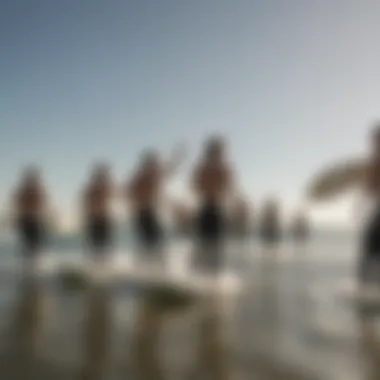
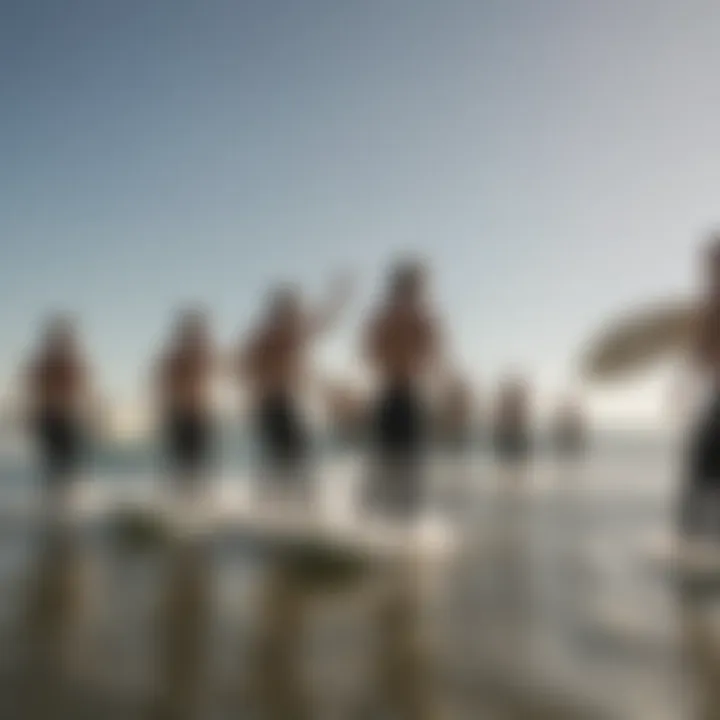
Private Coaching
When it comes to personalized instruction, private coaching is king. This one-on-one format ensures that every minute of the lesson is tailored to the student's specific needs. The key characteristic of private coaching is its adaptability; instructors can customize the curriculum based on individual skill levels, learning styles, and personal goals.
A prominent strength of private coaching lies in the immediate feedback a student receives. Whether a novice or an experienced surfer, private lessons can accelerate improvement by addressing individual weaknesses more effectively. Still, this format often comes at a higher price point, which can be a deterrent for some. If a more personalized experience is what you seek, the investment in private coaching could prove invaluable.
Online Courses
With the rise of digital learning, online surf courses have entered the scene, providing a different avenue for aspiring surfers. The significant advantage of this method is the flexibility it affords. Students can learn at their own pace, revisiting instructional videos as often as needed.
Such courses typically break down surfing concepts into digestible segments, making them approachable even for those who may feel overwhelmed by the thought of hitting the waves directly. However, a notable downside is the lack of hands-on experience. No matter how well one understands technique through a screen, nothing truly compares to the tactile sensation of real-world practice. Online courses are best used as a supplemental resource to traditional lessons or for those who want a foundation before committing to in-person instruction.
What to Expect During a Lesson
Surf lessons generally follow a structure that blends instruction, practice, and critique. Students can anticipate a warm welcome, during which instructors typically provide an overview of what to expect. Safety briefings often come first, highlighting essential information regarding surf etiquette and personal safety measures.
During the lesson, practical demonstrations are common. Students should be ready to hit the sand and the water while the instructor guides them through specific techniques, such as paddling or standing up on the board. Expect to spend a significant portion of the time practicing, as hands-on experience is invaluable in mastering surf skills.
Lastly, most lessons typically conclude with feedback sessions, allowing students to discuss what they’ve learned and areas for improvement. Engaging in this reflective process is crucial for growth, as it helps solidify understanding and cultivates a deeper connection with the surf community.
Understanding the structure of surf lessons not only prepares you for what lies ahead but also enriches the overall experience.
Ultimately, becoming well-versed in skate lessons enhances both the learning process and connection with surfing culture. Whether you choose group, private, or online lessons, knowing what to expect can make all the difference.
Locating Surf Schools
Finding the right surf school is a fundamental step for anyone looking to start their surfing journey in Australia. With some of the most pristine beaches in the world, the options can be both exciting and overwhelming. It's important to choose a surf school that fits your needs, as the right choice can make a significant difference in your learning experience.
Surf schools across Australia vary greatly in quality, curriculum, and location, so understanding these differences is key. Surfing isn’t just about riding waves; it’s also about embracing the local culture, safety, and skill development. When searching for a school, consider what each offers and how their approach aligns with your surfing goals.
Popular Coastal Regions for Surfing
New South Wales
New South Wales is often the poster child for surfing in Australia. With iconic beaches like Bondi and Byron Bay, it's no wonder surfers from all walks of life flock here. What sets New South Wales apart is its vibrant surf culture; you can find surf schools here that cater to all levels, from first-timers to seasoned surfers.
The key characteristic of New South Wales is its variety of surf breaks, which can challenge and nurture a range of skills. The surf schools often provide a more holistic approach, integrating local surf history and oceanography into lessons. A unique feature of this region is the range of surf spots accessible via public transportation, making it beneficial for travelers. However, the crowds can sometimes be a bit much, especially at popular beaches, which might be less appealing for those seeking a quieter learning environment.
Queensland
Known for its sun-drenched beaches and surf culture, Queensland holds its own as a premier surfing destination. The Gold Coast and Noosa Heads are standout locations with their stunning waves and a plethora of surf schools. Surfing here isn’t just a sport; it’s a lifestyle, ingrained in the local community.
The key feature of Queensland is its consistent waves, which can accommodate different skill levels. It's ideal for beginners who want stable conditions to learn on, while more advanced surfers can find challenging breaks during the right seasons. A unique advantage of surfing in Queensland is the chance to combine your lessons with other activities, like exploring national parks or snorkeling. However, prices for lessons can be a bit steeper, especially during peak seasons, which adds a layer of consideration for budget-conscious learners.
Western Australia
Western Australia offers a different vibe entirely, often less crowded than its east coast counterparts. The coastline stretches for miles, providing opportunities to experience diverse wave conditions. Places like Margaret River are famous worldwide, drawing surfers eager to tackle its challenging swells.
The key characteristic of Western Australia is its raw natural beauty, which provides a backdrop for surfing that's hard to beat. Many surf schools here emphasize outdoor adventure, offering not just lessons but also eco-tours and sustainable practices. A unique aspect of surfing in this region is the chance to ride waves alongside dolphins or enjoy a bonfire after a lesson. While the remoteness provides a unique, less commercialized experience, it may also necessitate longer travel times to reach some lessons.
Evaluating Surf Schools
Qualifications of Instructors
The qualifications of instructors play a crucial role in determining the quality of surf lessons. A certified instructor ensures that you receive proper training, emphasizing safety and skill development. Look for schools where instructors have not only completed accredited programs but also have extensive experience in teaching diverse groups.
A key element of having well-trained instructors is the ability to tailor lessons to individual needs. They're equipped to identify students' strengths and weaknesses, helping to foster growth in a supportive environment. Choosing a school with high-quality instructors often leads to a more productive and enjoyable learning experience.
Student-to-Teacher Ratios
The student-to-teacher ratio is another critical factor to consider when selecting a surf school. Having a low ratio means more personalized attention, which is especially beneficial for beginners. In a smaller group, instructors can focus on individualized tips and corrections, helping students progress faster.
A unique feature of schools with smaller ratios is the enhanced camaraderie among participants. You’ll likely find a friendlier atmosphere, which can boost your confidence in the water. That said, schools with higher ratios might be more affordable, but the trade-off is less attention for each student, which could slow the learning curve for some.
"In surfing, as in life, it’s not just about the destination; it’s about finding the path that works for you."
In summary, locating the right surf school is pivotal to your surfing journey in Australia. By considering the distinct characteristics of various regions and rigorously evaluating instructors and student-to-teacher ratios, you can make an informed decision that aligns with your surfing aspirations.
The Role of Safety in Surfing
When it comes to riding the waves, safety ain't just an afterthought — it's the very backbone of a good surfing experience. Surfing, while exhilarating, can bring both known and hidden dangers. Hence, cultivating an understanding of safety protocols and practices becomes essential for everyone, be they newbies or experienced riders.
As the saying goes, "Better safe than sorry!" This rings true in surfing. Not only does safety protect the individual surfer, but it also fosters a considerate community — one that values the shared joy of surfing and the well-being of its members. Whether it’s understanding etiquette on the waves or being equipped with the right gear, taking safety seriously can make all the difference between a memorable day at the beach and a day filled with regrets.
Understanding Surf Etiquette
Surf etiquette is the unwritten rulebook of the ocean. It’s about respect — both for the waves and for other surfers. Proper etiquette not only enhances safety but also enriches the surfing experience.
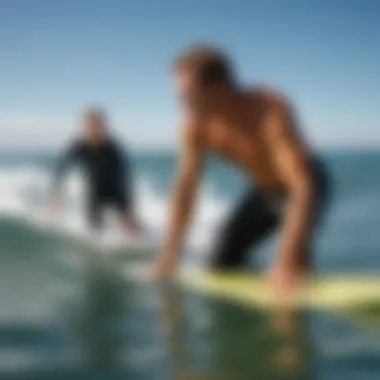
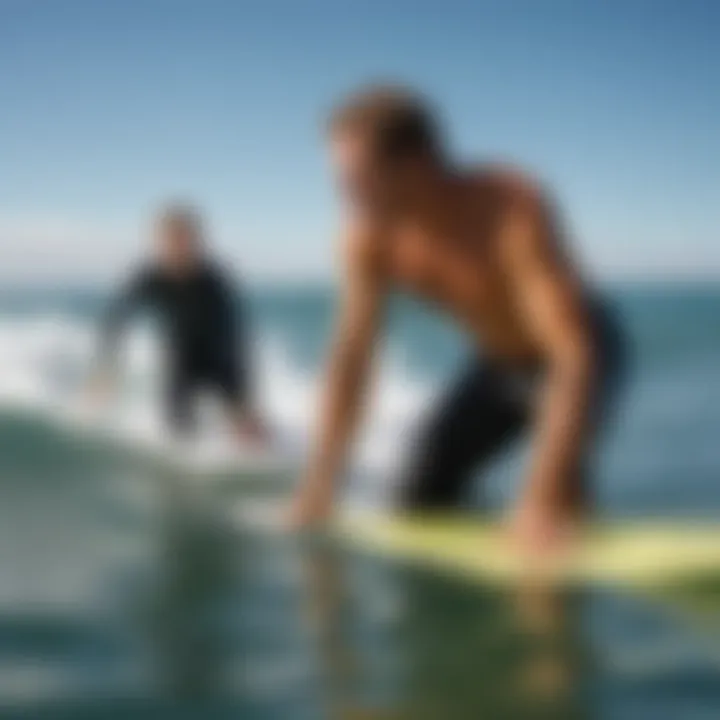
- Right of way: If someone is already on a wave or paddles closer to the peak, they have the right to ride it. Cutting off or dropping in on someone’s wave can lead to mishaps.
- Paddle around, not through: If you’re paddling out, avoid crossing paths with someone coming in. It’s common courtesy that makes the ocean a safer place.
- Clear communication: If you’re about to take off on a wave, shout out to others in the area. This helps to minimize the risk of collisions.
By adhering to these simple guidelines, surfers can significantly reduce hazards that arise from misunderstandings in the water. At the end of the day, it’s all about striking a balance between fun and safety.
Essential Safety Gear
Having the right equipment can mean the difference between enjoying a good day on the water and facing avoidable challenges. Here are a few key pieces of safety gear every surfer should have:
Leashes
Leashes keep you connected to your board, preventing it from drifting away after a wipeout. This is crucial, especially in busy waters where a loose board can become an unintentional missile. Most notably, a sturdy leash has a key characteristic: it’s essential for everyone's safety.
But leashes can vary in thickness and material. Some surfrs prefer thicker leashes for bigger waves, while lighter weights work for smaller swells. The unique feature of a leash is its ability to reduce the risk of collisions — both for the surfer and for other individuals in the water. Yet, they can sometimes get tangled, leading to setbacks if not managed correctly.
Wetsuits
Ah, the wetsuit. Often seen as a barrier between you and the chilly waters, wetsuits serve multiple purposes. They provide thermal insulation, allowing surfers to stay in the water longer even when the temperature drops. Another key characteristic is their buoyancy, which contributes to overall comfort and safety.
Moreover, they help protect the body from sunburn and abrasions caused by the board or rocky surfaces. The downside? They can be somewhat restrictive during the initial wear. Finding the right fit is essential to reap the wetsuit's benefits while maintaining comfort.
Helmets
While not as common in everyday surfing, helmets are becoming more recognized, especially in areas with greater risks like reef breaks or amongst more aggressive surfing styles. A helmet is designed to shield your noggin from unexpected impacts, whether it’s a wipeout or a collision with another surfer's board.
The unique feature of helmets is their padded interior, which adds an extra layer of protection. While some might argue they add unwanted weight or may feel uncomfortable, the safety advantages often outweigh these minor concerns. Educating oneself on the benefits of helmets can encourage their widespread acceptance amongst surfers.
"Safety is not just a choice, but a way to ensure our enjoyment of this beautiful sport."
By embracing safety gear, practicing proper etiquette, and being conscious of surroundings, surfers can navigate the fluid dynamics of the sea with much greater confidence. Remember: safety in surfing means riding the waves smartly and happily.
Techniques for Beginners
Learning to surf in Australia is as much about the techniques as it is about the experience. For novices, mastering the fundamentals can significantly shape one’s journey into the thrilling world of surfing. It’s overwhelming at first, but focusing on the basics paves the way for confidence and skill development. While catching a wave might look straightforward, it requires a combination of balance, strength, and technique. Understanding those initial steps can make the ride smoother and much more enjoyable.
Paddling Techniques
Paddling is arguably one of the most crucial techniques for a beginner surfer. If you can’t paddle efficiently, you might find yourself struggling to catch waves or, worse yet, tiring out too quickly.
Here are a few key points on paddling techniques:
- Positioning on the Board: Lying flat on the surfboard is essential. Your hips should be centered and ideally positioned around the mid-point of the board. A very common mistake is lying too far back, which can lead to the board nosediving.
- Arm Movements: Use a freestyle stroke motion with your arms. Instead of splashing and flailing, aim for smooth and deliberate motions. Regularly alternate your arms, with each stroke propelling you forward. Keeping them elongated helps maintain balance, essential for navigating the waves.
- Breath Control: It might sound trivial, but controlling your breathing while paddling can help significantly. Exhaling while you paddle reduces drag and allows for better control when catching waves.
Effective paddling is more than just muscle power; it’s about technique, coordination, and getting accustomed to the water. Becoming proficient can boost your confidence, enabling you to focus more on the actual surfing part.
Standing Up on the Board
Once a beginner has got the hang of paddling, the next challenge is standing up on the board. This is where many learners face the classic struggle—transitioning from lying down to an upright position on the board. However, this is also where the magic happens; standing gives you the chance to ride those beautifully rolling waves.
Key points to master this skill include:
- Timing: Stand up just when the wave is about to lift you. This is often when the board starts to glide forward due to the wave's motion. Missing this moment can lead to a rather ungraceful spill.
- Foot Placement: As you rise, your feet should land shoulder-width apart. Think of it as a sturdy triangle; your front foot should point forward while your back foot angles slightly for balance. If you overthink it, you may lose the straightforward motion and risk falling.
- Body Weight Distribution: Leaning too far forward can fling you off the board, while leaning back may stall your progress. Keeping a low center of gravity by bending your knees helps maintain balance and control.
Quote: "Practice makes perfect, and in surfing, the more you practice your stance, the more natural it becomes."
Understanding the paddling technique and how to stand on the board forms the bedrock for every surfer's future experiences. Mastering these steps not only accelerates your learning but can also enhance the fun factor immensely. With practice, patience and guidance, those initial struggles will eventually transform into delightful rides on Australia's stunning waves.
Cultural Aspects of Surfing in Australia
Surfing in Australia goes way beyond just catching waves. It’s woven into the very fabric of the coastal lifestyle. Understanding the cultural aspects can not only enhance your experience but also deepen your appreciation for what surfing represents in this sun-kissed nation. The surfing culture here is a blend of historical significance, respect for the land, and community connection.
Connection to Indigenous Traditions
Indigenous Australians have a long history that’s tied closely to the ocean and the waterways, making their relationship with nature incredibly profound. Before surfers hit the waves with boards, the land and sea were already here, sustaining generations of communities.
One cannot ignore the wisdom shared through stories, songs, and dance about the spiritual connection between the Indigenous peoples and the water. In some regions, surfing is seen as a form of expression that respects and honors these traditions rather than merely a recreational activity. For instance, some surf schools invite Indigenous instructors to teach not just surfing, but also the cultural narratives that come with it. This creates a richer, multidimensional experience for participants. It’s a humbling reminder that the waves we ride today have always been part of a larger story.
Influence of Local Communities
In every corner of Australia’s coastline, you’ll find unique local surf communities, each with its own character. The surfer camaraderie is something special – think of it as a brotherhood or sisterhood that’s created over shared experiences, whether it’s conquering gnarly waves or simply sipping a cold drink at sunset after a long day in the water.
Take a trip to Byron Bay or Margaret River, and you’ll see surf shops filled with local artwork, boards crafted using sustainable methods, and coffee shops where surfers swap stories about the day’s surf. This reflects a strong sense of community values, where locals support one another, often leading to collaborative surf events or beach clean-ups.
Community-driven initiatives can also be seen in the way local events are organized. Surf competitions, festivals, and workshops often welcome all skill levels, strengthening ties among local surfers while creating a welcoming space for newcomers. This encourages climate stewardship, with many groups actively participating in ocean conservation efforts.
Through these connections forged in saltwater, surfing transcends beyond just a sport; it becomes a lifestyle and a communal journey. The ethos is that of respect— for the ocean, for the culture, and for the individuals who share the surf.
"Surfing is a bridge that connects us to our roots, our community, and our environment. It is a language spoken by the waves and understood by those willing to listen."
In summary, the cultural aspects of surfing in Australia are vital to understanding its true essence. This beautiful sport is not merely about riding waves but embracing traditions, fostering communal ties, and nurturing a respect for nature. As you embark on your own surfing journey in Australia, take a moment to reflect on the rich cultural landscape that surrounds you, and let that inform your experience.
Weather and Surf Conditions
Understanding the influence of weather and surf conditions is crucial for anyone looking to take surf lessons in Australia. The unique geography and long stretch of coastline means that weather patterns can vary significantly from one location to another, making it imperative for both novices and seasoned surfers to comprehend how these elements impact surfing activities.
Weather conditions, including wind speed and direction, play a vital role in the quality of waves. Leo, an avid surfer from Sydney, often notes that just a slight shift in the wind can turn choppy waters into a surfer’s paradise. On the flipside, adverse weather can create risks and should never be taken lightly. For those new to surfing, it’s wise to be aware that popular surf schools usually monitor these conditions closely, ensuring safety and a more enjoyable learning experience.
"The only thing worse than a bad wave is a bad decision made while on a board."
Additionally, surf conditions also rely heavily on tides and swells. During certain tidal phases, waves can become more consistent and favorable for learning. Understanding these aspects can unlock more suitable times for surfing lessons.
Understanding Tides and Swells
Tidal movements can create diverse surfing environments, rather like an artist's palette. The difference between high tide and low tide can influence not only the size of the waves but also their break patterns.
- High Tide: Waves may become more pronounced and can break closer to the shore, offering an exhilarating experience for those who are ready for it.
- Low Tide: Waves tend to be smaller and more forgiving, making them ideal for beginners to practice without the intimidation of larger surf.
Swells, which can originate from storms far out at sea, affect wave height and power. These swells can make or break a surfing session, so it’s essential that surfers remain informed about upcoming swell patterns. Resources like surf forecasting websites can be indispensable for planning effective surf lessons.
Seasonal Variations in Surfing
Seasons affect more than just the weather; they significantly contribute to the surfing landscape in Australia. As summer turns to winter, changes in water temperature and wave behavior become evident.
- Summer (December to February): Generally brings more consistent and mellow waves. It’s a prime season for beginners who might feel nervous about catching bigger swells. However, this is also peak tourist season, leading to crowded beaches.
- Autumn (March to May): Often hailed as the best season for surfing. Less wind, stable weather patterns, and warmer water temperatures can sometimes create dreamlike conditions.
- Winter (June to August): Can be daunting with bigger swells and chilly water. However, experienced surfers thrive during this season, taking advantage of the powerful waves that winter storms bring. But for beginners, this season often means a sharper learning curve.
- Spring (September to November): As the water warms up, so do the waves, creating opportunities for both seasoned surfers and newcomers.
When planning surf lessons, consider these seasonal variations as they can greatly enhance or impede your surfing journey. Proficient surf schools will tailor their lessons according to these elements, ensuring that learners make the most out of their time in the water.
Maximizing the Surf Experience
When it comes to surfing, the experience you gain can be the cherry on top of your learning journey. Maximizing it means thinking beyond just catching waves. It involves understanding the nuances of surf equipment, honing skills after lessons, and tapping into resources that elevate your surfing game. Each wave presents an opportunity to refine your technique and deepen your connection to the surf culture.
Choosing the Right Equipment
Selecting a Surfboard
Choosing the right surfboard isn't a mere matter of preference; it's foundational to both your learning curve and enjoyment. The right board can set you up for success or leave you frustrated, tumbling into the whitewater. When selecting a surfboard, beginners often benefit from soft-top boards. These boards are easier to balance on, providing added stability.
What's more, soft-tops lessen the sting of wipeouts, serving as a critical safety feature. A key characteristic is that they typically come in longer lengths, which helps with paddling. If you're just starting your surf journey, this type of board can make riding the waves much more accessible.
The downside? Well, soft-top boards might not perform as well in larger, more challenging waves, limiting their versatility as you progress. However, for beginners, they’re a wise choice and will bolster that essential initial confidence.
Understanding Board Types
Getting your head around board types is crucial. There’s a variety of surfboards out there—short boards, longboards, fish, and funboards, each offering a unique vibe and experience. For novices, longboards are often suggested due to their buoyancy and stability.
The primary feature of longboards is their length, which will help in paddling and getting up on your feet. This can be a game changer when you are still figuring it all out. Using a longboard can even make it easier to catch smaller, mellow waves, providing that early feeling of accomplishment.
As your skills grow, you might find longboards limiting in performance in more buoyant swells or tighter turns. Shorter boards, while trickier to balance, offer a more dynamic ride as you progress.
Post-Lesson Tips for Improvement
Improvement in surfing doesn't end when the lesson does. Engaging in after-class practices is vital. These can include simple things like spending time studying wave patterns or checking out videos of surfing techniques.
Think about keeping a surf journal, documenting what worked during lessons and areas to improve. This can help reinforce learning, making each wave count even more.
And don't forget to engage with your community—link up with experienced surfers. They often have valuable nuggets to share, whether it’s a local spot with better conditions or techniques that streamlined their learning. Surfiing is not just about getting on a board; it’s about the culture, the friendships formed, and the memories created.
Remember: Surfing is a journey, not a race. Finding joy in the process is key.
In summary, maximizing your surf experience entails wise choices around equipment, ongoing skill development, and actively engaging with the surf community. The ocean is vast, and there’s always more to learn, experience, and enjoy.
Further Resources for Learning
In the realm of surfing, the journey of mastering this exhilarating sport doesn't halt upon leaving the surf school. Rather, it is a continuous endeavor that thrives on knowledge, practice, and community engagement. This section dives into key resources that can augment your surfing acumen, making the most out of every wave you catch. By tapping into these avenues of learning, surfers can better understand techniques, weather conditions, and surfing culture, ensuring they’re always one paddle ahead.
Books and Manuals
Books and manuals serve as a treasure trove of information for surfers, offering comprehensive insights on techniques, safety protocols, and even historical context around the sport. Reading about various aspects of surfing can deepen your appreciation and understanding of the waves.
- Technique Guides: Look for instructional books that cover everything from the basics of paddling to advanced maneuvers like aerials and cutbacks. "Surfing: A Beginner's Guide" provides simple visuals and explanations perfect for newcomers.
- Safety Manuals: Understanding ocean safety is paramount. Books that cover rip tides, local wildlife, and environmental conditions can prepare you for any situation. Titles like "Surf Safety: The Complete Guide" are invaluable for this crucial knowledge.
- Cultural Perspectives: Surfing is not just a sport; it’s a lifestyle intertwined with local cultures. Books that examine the history and evolution of surfing, such as "The History of Surfing in Australia", can provide insight into its significance.
Investing time in reading these resources can elevate your surfing experience, allowing you to approach lessons and sessions with more context and understanding.
Online Forums and Communities
Online forums and communities are the buzzing hive of contemporary learning, especially for something as dynamic as surfing. They offer a platform where enthusiasts can connect, share experiences, and learn from each other.
- Reddit: Engage with the r/surf subreddit where surfers from all walks of life come together. Here, you can ask questions, share stories, or dive into discussions about gear or local spots.
- Facebook Groups: Join local surfing communities on Facebook where members share tips about surf conditions, gear recommendations, and personal experiences. These platforms are particularly useful for gaining insight tailored to your specific location.
- Dedicated Surfing Forums: Websites like Surfer Magazine and Surfline host forums where seasoned vets and newbies alike discuss everything from the best surf spots to the latest trends in board technology.
"Building a supportive community is as important as mastering the waves. Learning from others can offer perspectives you might not find in a manual, enriching your journey in surfing."
Accessing these resources can provide surfers with diverse viewpoints and tips, broadening their horizons both in terms of knowledge and practical traction on the waves.







